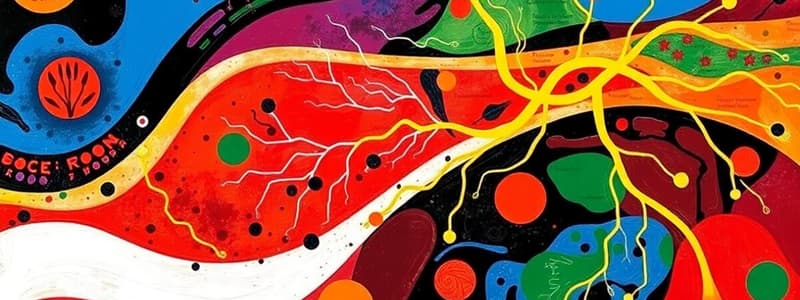Podcast
Questions and Answers
Which of the following is the primary source of energy input to biological systems?
Which of the following is the primary source of energy input to biological systems?
- Consumers
- The Sun (correct)
- Producers
- Decomposers
A food web illustrates a single, linear sequence of energy transfer among organisms in an ecosystem.
A food web illustrates a single, linear sequence of energy transfer among organisms in an ecosystem.
False (B)
What is the role of a decomposer in an ecosystem?
What is the role of a decomposer in an ecosystem?
Decomposers break down dead or waste organic material to obtain energy.
An organism that produces its own organic nutrients using energy from sunlight is called a/an ______.
An organism that produces its own organic nutrients using energy from sunlight is called a/an ______.
Match each consumer type with its feeding behavior
Match each consumer type with its feeding behavior
Which process involves the breakdown of nutrient molecules to release energy using oxygen?
Which process involves the breakdown of nutrient molecules to release energy using oxygen?
Antibiotics are effective against viral infections.
Antibiotics are effective against viral infections.
Give an example of how habitat destruction can affect biodiversity.
Give an example of how habitat destruction can affect biodiversity.
The transfer of pollen grains from an anther to a stigma is known as ______.
The transfer of pollen grains from an anther to a stigma is known as ______.
Which of the following is NOT a reason for habitat destruction?
Which of the following is NOT a reason for habitat destruction?
Match the gas exchange surface feature with its primary function:
Match the gas exchange surface feature with its primary function:
Active immunity is acquired immediately after exposure to a pathogen.
Active immunity is acquired immediately after exposure to a pathogen.
What is the importance of sewage treatment in controlling the spread of disease?
What is the importance of sewage treatment in controlling the spread of disease?
In the context of a flower, where does fertilization occur?
In the context of a flower, where does fertilization occur?
The balanced symbol equation for aerobic respiration is $C_6H_{12}O_6 + 6O_2 \rightarrow$ ______ + $6H_2O$.
The balanced symbol equation for aerobic respiration is $C_6H_{12}O_6 + 6O_2 \rightarrow$ ______ + $6H_2O$.
Which of the following is an example of indirect transmission of a pathogen?
Which of the following is an example of indirect transmission of a pathogen?
Increasing the rate and depth of breathing during physical activity does not affect gas exchange in the lungs.
Increasing the rate and depth of breathing during physical activity does not affect gas exchange in the lungs.
A disease that is transmissible is one in which the pathogen can be passed from one host to another.
A disease that is transmissible is one in which the pathogen can be passed from one host to another.
How does climate change lead to species endangerment or extinction?
How does climate change lead to species endangerment or extinction?
Match each conservation strategy with its description:
Match each conservation strategy with its description:
Flashcards
What is the sun's role in ecosystems?
What is the sun's role in ecosystems?
The sun provides the primary energy input to biological systems.
How does energy flow in ecosystems?
How does energy flow in ecosystems?
Energy flows from the sun to living things as light energy, then as chemical energy, eventually transferring out to the environment.
What is a food chain?
What is a food chain?
A food chain shows energy transfer from one organism to the next, beginning with a producer.
What is a producer?
What is a producer?
Signup and view all the flashcards
What is a consumer?
What is a consumer?
Signup and view all the flashcards
How are consumers classified?
How are consumers classified?
Signup and view all the flashcards
What is a herbivore?
What is a herbivore?
Signup and view all the flashcards
What is a carnivore?
What is a carnivore?
Signup and view all the flashcards
What is a decomposer?
What is a decomposer?
Signup and view all the flashcards
What processes are involved in the carbon cycle?
What processes are involved in the carbon cycle?
Signup and view all the flashcards
What is an ecosystem?
What is an ecosystem?
Signup and view all the flashcards
What is biodiversity?
What is biodiversity?
Signup and view all the flashcards
Why do organisms become endangered?
Why do organisms become endangered?
Signup and view all the flashcards
What is active immunity?
What is active immunity?
Signup and view all the flashcards
What defines a drug?
What defines a drug?
Signup and view all the flashcards
What are antibiotics used for?
What are antibiotics used for?
Signup and view all the flashcards
What is pollination?
What is pollination?
Signup and view all the flashcards
What is fertilization?
What is fertilization?
Signup and view all the flashcards
What conditions affect seed germination?
What conditions affect seed germination?
Signup and view all the flashcards
What parts make up the male reproductive system?
What parts make up the male reproductive system?
Signup and view all the flashcards
Study Notes
Organisms and Their Environment
Energy Flow
- The sun serves as the main energy source for biological systems.
- Energy passes through living things, starting as light energy from the sun, then as chemical energy within organisms, before eventually being released into the environment.
Food Chains and Food Webs
- A food chain illustrates how energy is passed from one organism to the next, commencing with a producer.
- Constructing and interpreting simple food chains is essential to understanding energy transfer.
- A food web comprises multiple interconnected food chains and their interpretations.
- Producers are organisms that produce their own organic nutrients, primarily through photosynthesis, using sunlight.
- Consumers get energy by consuming other organisms.
- Consumers are classified as primary, secondary, or tertiary based on their position in the food chain.
- Herbivores are animals deriving energy from plants.
- Carnivores are animals deriving energy by consuming other animals.
- Decomposers obtain energy from dead or waste organic matter.
- Food chains and webs can show the effects of human actions, such as overharvesting or introducing foreign species, on a habitat.
Carbon Cycle
- The carbon cycle includes photosynthesis, respiration, feeding, decomposition, formation of fossil fuels, and combustion
Human Influences on Ecosystems
Habitat Destruction
- An ecosystem includes the community of organisms and their environment interacting together.
- Biodiversity refers to the number of different species inhabiting a specific area.
- Habitat destruction arises from increased land use for, housing, agriculture, and livestock.
- Habitat destruction also occurs due to extraction of natural resources and freshwater/marine pollution.
- Deforestation leads to reduced biodiversity, extinction, soil loss, flooding, and increased atmospheric carbon dioxide.
Conservation
- Organisms are endangered or extinct because of climate change, habitat destruction, hunting, overharvesting, pollution, and introduced species.
- Endangered species can be conserved through monitoring, habitat protection, education, captive breeding programs, and seed banks.
Gas Exchange in Humans
Gas exchange in humans
- Key components of the breathing system include the lungs, diaphragm, ribs, intercostal muscles, larynx, trachea, bronchi, bronchioles, alveoli, and associated capillaries.
- Physical activity impacts the rate and depth of breathing.
- Gas exchange surfaces in humans have a large surface area, thin surface, good blood supply, and good ventilation with air.
Respiration
Respiration
- Energy in living organisms is used for muscle contraction, protein synthesis, cell division, growth, and maintaining body temperature.
- Aerobic respiration involves chemical reactions where cells use oxygen to break down nutrient molecules and release energy.
- The word equation for aerobic respiration is: glucose + oxygen → carbon dioxide + water.
- The balanced symbol equation for aerobic respiration is: C6H12O6 + 6O2 → 6CO2 + 6H2O.
Diseases and Immunity
Disease and Immunity
- A pathogen is a disease-causing organism.
- A transmissible disease can be passed from one host to another.
- Pathogens transmit through direct contact (blood, body fluids) or indirectly (contaminated surfaces, food, animals, air).
- The body's defenses against pathogens include: skin, hairs in the nose, mucus, stomach acid, and white blood cells.
- Viruses have a protein coat and genetic material.
- Controlling disease spread involves clean water, hygienic food preparation, personal hygiene, waste disposal, and sewage treatment.
- Active immunity is a defense against pathogens achieved through antibody production in the body.
- Active immunity is acquired after infection or vaccination.
Drugs
Drugs
- A drug is any substance modifying or affecting chemical reactions in the body.
- Antibiotics treat bacterial infections.
- Some bacteria are resistant to antibiotics, reducing their effectiveness.
- Antibiotics only kill bacteria and do not affect viruses.
- Limiting antibiotic use prevents the development of resistant bacteria like MRSA.
Reproduction
Sexual Reproduction in Plants
- A insect-pollinated flower consists of: sepals, petals, stamens, filaments, anthers, carpels, style, stigma, ovary, and ovules.
- Pollination transfers the pollen grains from an anther to a stigma.
- Fertilization occurs when a pollen nucleus combines with a nucleus in an ovule.
- Seed germination needs water, oxygen, and a suitable temperature.
- Wind-pollinated flowers contain anthers and stigmas.
Sexual Reproduction in Humans
- The male reproductive system includes: testes, scrotum, sperm ducts, prostate gland, urethra, and penis.
- The female reproductive system includes: ovaries, oviducts, uterus, cervix, and vagina.
- Fertilization is the fusion of nuclei from a male gamete (sperm) and a female gamete (egg cell).
- The menstrual cycle includes changes in the ovaries and the lining of the uterus.
Studying That Suits You
Use AI to generate personalized quizzes and flashcards to suit your learning preferences.




